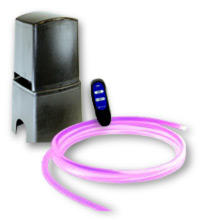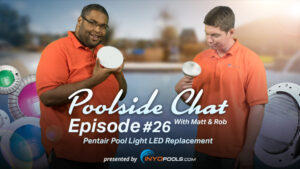Hello, pool pals and compatriots it’s your faithful friends Matt and Rob with another chapter of Inyo’s pool equipment selection series; and today’s subject is the always-illuminating topic of Pool Lighting. There are three main genres of pool light; Standard incandescent, LED and Fiberoptic. Let’s focus on the basics of each and then we’ll figure out which is the best for you and your pool. First up is the Incandescent.
Incandescent Bulbs

Incandescent fixtures are lit by filament or halogen bulbs, comparable to outdoor flood lamps except larger, more powerful and underwater, of course. These lights make night time poolscapes sparkle with an appealing soft white glow, shown by bulbs ranging from 300, 400, and 500 watts. If you are looking for a crisp clean gleam to your pool, these lights will do wonders.
The incandescents major advantage is its low upfront cost. For example, the Pentair Amerlite and Hayward Astrolite fixtures are much cheaper than their LED counterparts. While the lower upfront cost is nice, their downside is the higher operational and maintenance costs, like replacing the bulbs.
In engineering, your design is only as strong as its weakest part, and for these fixtures, it’s the bulb. Filament bulbs have a relatively short 2,000-hour lifespan.
So every time a bulb blows, you have to pull the pool light on deck, change the bulb, and replace the lens gasket. Over the lifetime of a fixture, that maintenance could add up to 100 to 200 dollars, before labor.
The incandescent lights are only available in white. Some fixtures offer various colored lenses to spice up your pool but these lenses can be a pain to pop on and off. If you want color, our next pool light option is probably the best for you.
LED Bulbs
LED Pool lights have a great combination of energy efficiency, longevity and dazzling colors in one little package. When compared to the standard incandescent 500 watt light, a 5g LED pool light consumes little more than a tenth of the power.

LEDs are built to last, their bulbs or modules are generally rated for 30,000 or more operational hours.
There’s a good chance a pool owner won’t spend 30,000 hours in a pool in their lifetime, let alone while it’s lit. So you should get a very long use out of these lights.
But the real reason to get one of these bad boys are the light shows that change your pool from bleh, to PAAAAAAARTAY (or whatever)
Various LED models have fun named light shows like California Sunset, Northern Lights, Patriot Dream and Supernova that fade to or flash colors all throughout the spectrum.
Now it is not all fun in the world of LED. The LED light fixtures cost about twice as much as an incandescent light. And if you go with an LED bulb it will run as much as a complete incandescent light.
Plus these bulbs are not as bright as their incandescent cousins. The watt equivalency falls between 250 to 300 for the brightest LED bulbs. Also, colors like Red and Purple do not travel as far as Blue and White light, meaning they may not reach the full length of your pool. (rewrite)
While these color changing LEDs work great in light colored pool surfaces, they do not work well in dark surfaced pools. Reason being, the dark surface absorbs the colors. So if you have a dark colored pool but want the benefits of an energy efficient LED, we recommend an all white LED light.
With all that said, LED bulbs are becoming the favorite for new pool installations as well as retrofits for older lights.

Speaking of old, now we move onto to discussing fiber optics.
Fiber Optics
What is this 1998, we ain’t talking about fiber optic.
Ok, well fiber optic systems are made of two components, an illuminator, and the fiber optic cable. The illuminator houses the light source which is either a halogen light, with an optional color wheel or an led light assembly which resembles a ray gun.
Fiber optic cable is then plugged into the illuminator. When the illuminator is on, the light passes through the cable. There are two types of fiber optic cable side glow (for perimeter) and end glow (underwater).
The major drawback of fiber optics is that it’s by far the most expensive option on this list and kind of a hassle to install. After the cost of the illuminator, cable, cable tracks with assorted accessories and labor, you’ll wish you had just gone with another option.
Bulb Voltage: 120-Volt & 12-Volt
A question we get a lot from customers is, does it matter if I go with 120 or 12 volts? That answer boils down to personal preference and code restrictions in your area.
Fixtures operating on 120 volts pull their power directly from a power source with no intermediary device. But in 12-volt fixtures, a transformer is installed on the circuit between the 120-volt receptacle and the light. The transformer steps down the 120 to 12 volts to a “safe” voltage to protect any swimmer if there is a short.
Some local codes and a large percentage of commercial installations require 12-volt lights. But that is not to say 120 is unsafe, chances are you have swum in pools lit by 120 volts your entire life. If properly bonded no issues should arise.
Ok now we have hopefully figured out which type of light we want, and we know what voltage we have, now it’s time for the little things. Like cable length, the niche, and controlling the light.
Light Niche
The container that holds the light in your pool wall is called the niche. These are made of metal or plastic.
Each light has at least two niches that are compatible with its fixture, one for fiberglass/vinyl and another for gunite pools. The fiberglass/vinyl models include a gasket package to help seal the seam around the niche.
Cable Length
To determine cable length required for the installation, we need to measure the cable’s expected travel distance from the niche to the power source. If you plan to use a junction box.measure from the box to the niche. Make sure you measure height rise from the niche to the power source as well as distance.
An important thing to remember, pool light cables can not be spliced or extended so it is best to upsize your cord length to be on the safe side.
If you estimate you need 45 feet of cable to reach the power source, I suggest getting the 75 foot or longer. This allows for any miscalculations. and adds slack to the line so you can pull the fixture up on the deck for maintenance.
And now finally, how do we control our lights once they are installed?
Light Controllers
Generally, there are two control options for your incandescent and LED lights; they are, a manual wall switch or an automated timer.
The simplest solution is wiring your pool light to a nearby light switch so your pool is one flick away from stunning.
Hooking up your LED bulb or fixture to a light switch allows you to cycle through your light shows and solid colors. If you have a Pentair Intellibrite, a cool add-on is Pentair’s optional controller which has a dial that you can easily set for a specific color or show.
If you prefer to be hands off, there are control and timer options that can automate your lighting and the whole pool from a handheld or wall mounted remote. Or better yet from your phone. But we will save that for our next segment of this selection series when we cover pool controls and timers.
But for now, thank you for joining us, and if you find these videos helpful, subscribe to our youtube channel and stay tuned for the next edition of our selection series.













Leave a Reply